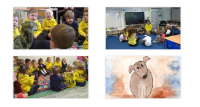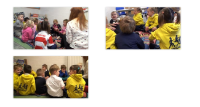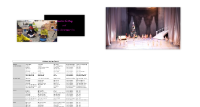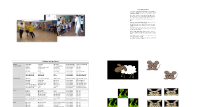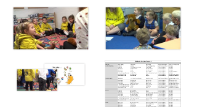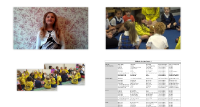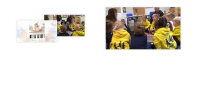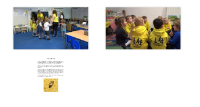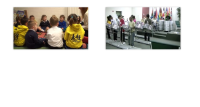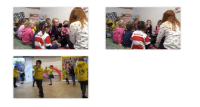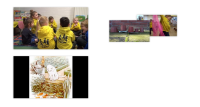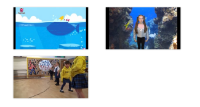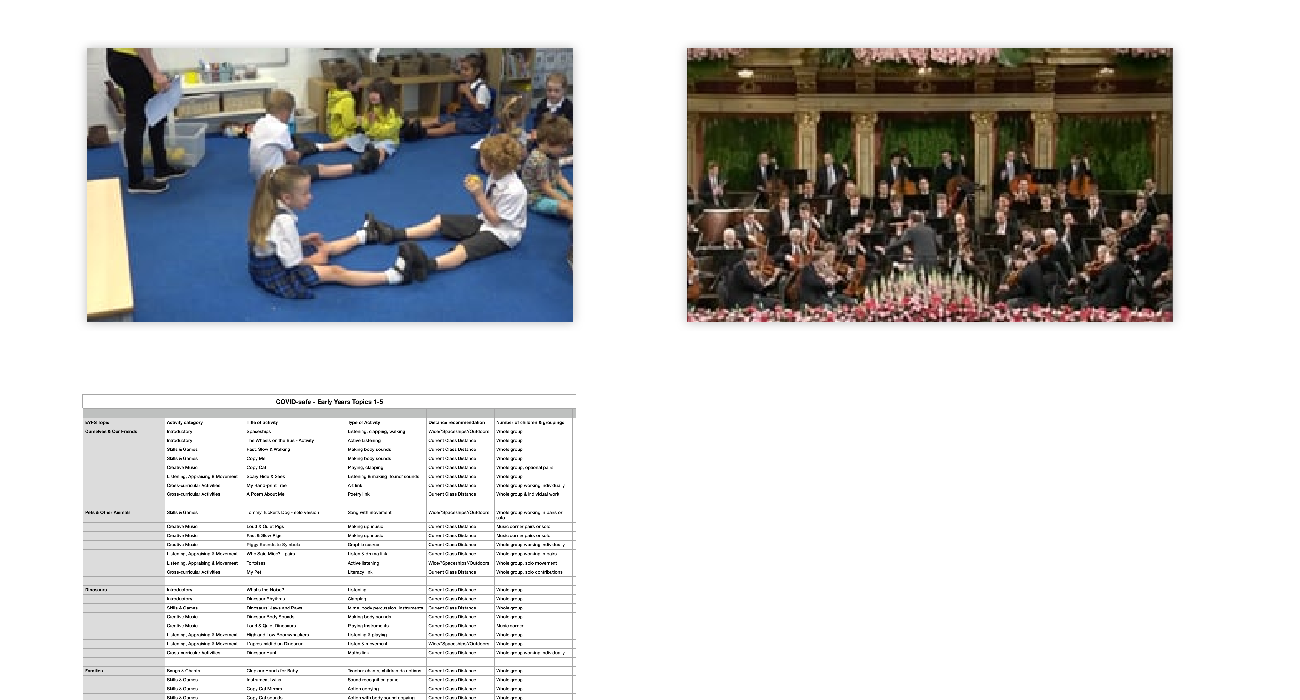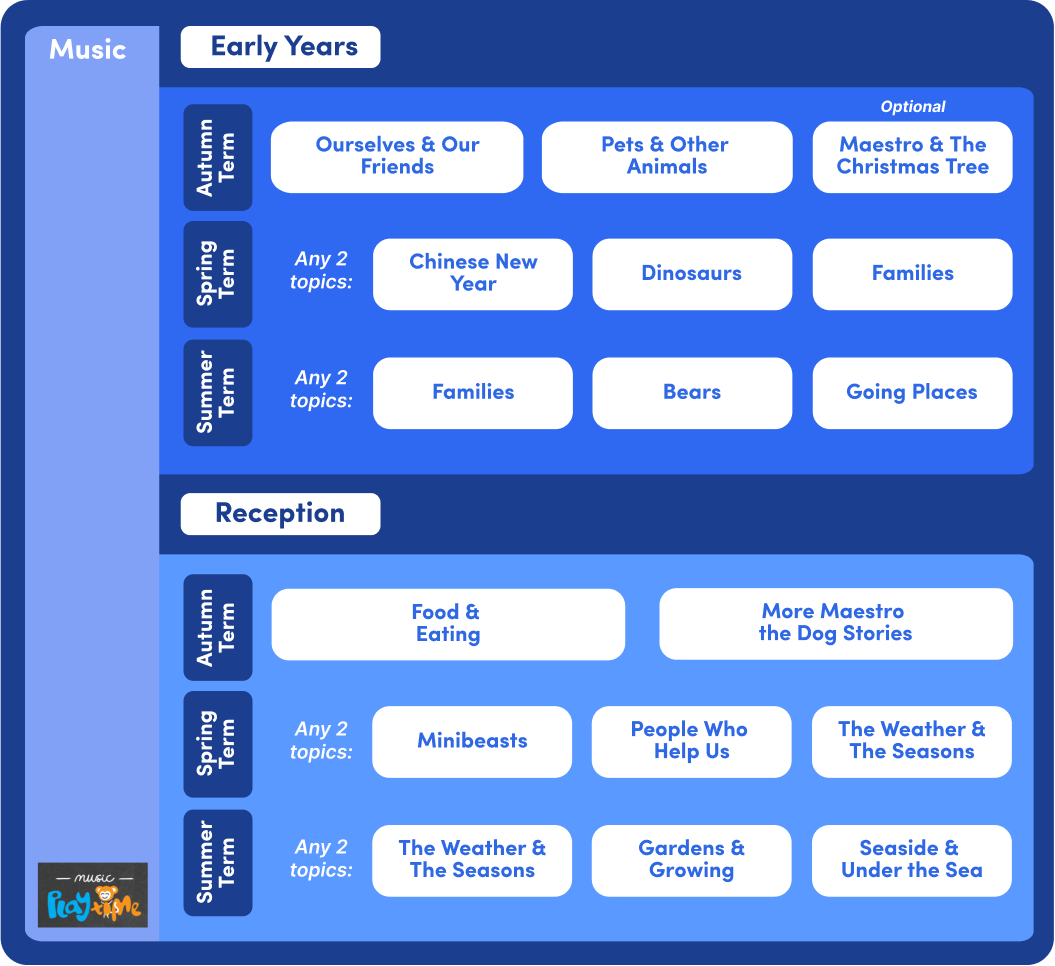Going Places Level: Early Grades
Music Unit Description
This unit is about going places via all sorts of different transport.
Elements
- Tempo: Fast or slow speed of the PULSE, or BEAT
- Duration: Long or short notes, RHYTHM.
- Dynamics: Louder or quieter sounds.
- Structure: The way music is constructed.
- Pitch: High pitched and low pitched sounds.
Resources
- Untuned percussion instruments
- Medium sized spongy balls
- Toy trains, cars and buses
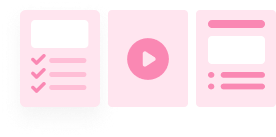
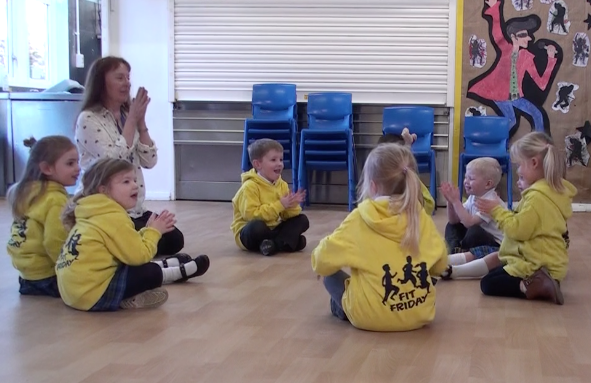
One Two Buckle My Shoe - three ways!
Pulse
A rhyme for going places! It's ideal for doing actions or for tapping knees in time with the pulse. You'll need to model keeping a steady pulse by doing big actions for the children to copy. Here's how it sounds:
Rhythm
The children encounter the same rhythms again later in this unit, in the Creative Music section so this chant is good preparation, followed by later consolidation. Once the children know the words, they can tap out the rhythms too - I suggest you do this just one line at a time in a First Me, Then You way.
Pitch
You can also sing-song this rhyme:
- One two, buckle my shoe
- Three four, open the door
- Five six, picking up sticks
- Seven eight, go through the gate
- Nine ten, say it again!
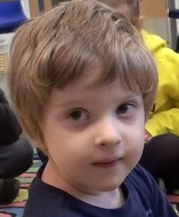
On the Bus - for developing listening skills
This is an active listening game, good for expending some energy. First, lay parallel lengths of skipping rope to make the 'road', the 'bus' and the 'train'. With the children facing you, show the 'road' in the middle, the train on one side and the bus on the other side and have a little practice moving from one to the other. To play the game, call out in random order:
- 'On the bus'
- 'On the train'
- 'In the road'
It's surprising how much fun this game can be!


Can You Hear the Train? (dynamics, tempo)
The original song, included here with the permission of Lancashire Music Service, the original publishers, was just one verse but I liked it so much that I made up extra ones. When the children know the song, practise singing it slowly and then gradually quicker.
After singing the song, everyone chant 'Chugging along, chugging along' starting slowly and quietly then getting louder and quicker as the train comes closer, then gradually slower and quieter as the train goes away. The teacher leads the tempo (speed) and dynamics (volume changes) by making a big arc shape with arm movements. For the changes in loud and quiet, encourage whispering through to loud voices, but never shouting.
- Can you hear the train?
- Can you hear the train?
- Speeding through the town and then
- Slowing down again
- __
- Can you hear the bus?
- Can you hear the bus?
- Taking children home from school
- Hope it stops for us
- __
- Can you hear the plane?
- Can you hear the plane?
- Taking us on holiday
- Hope it doesn't rain
- __
- Can you hear the car?
- Can you hear the car?
- Driving to the swimming pool
- Hope it isn't far
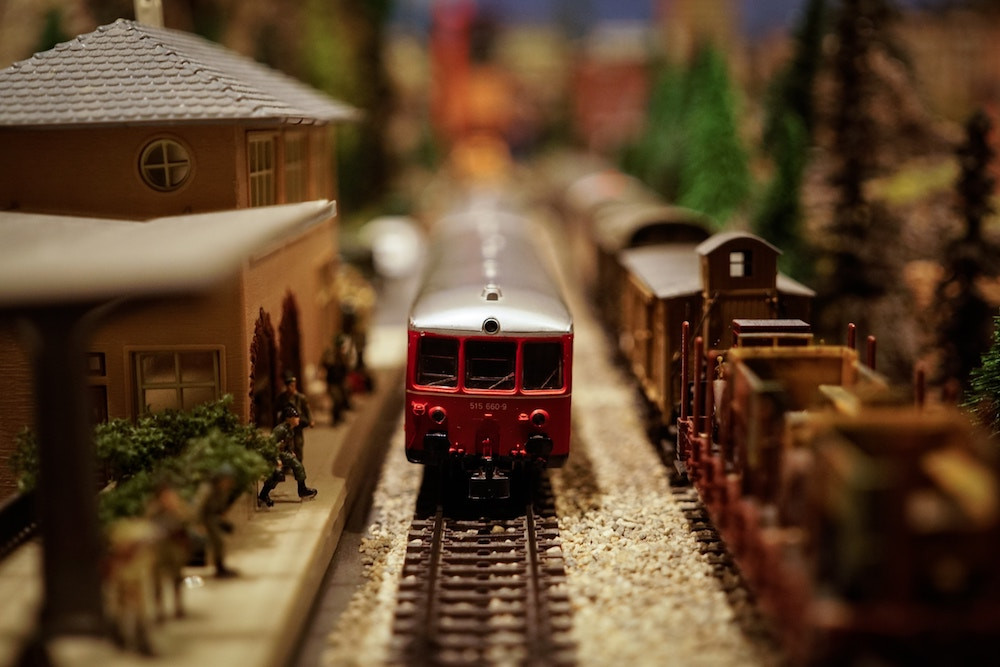
Lightly Row
This tune seems to appear in virtually every tutor book for every instrument so it's really well-known but I didn't realise for years that it's actually an old song! Verse 1 lends itself to doing rowing and gliding actions and verse 2 could have splashing and swimming actions. I've altered some of the words to make them more suitable for children.
- Lightly row, lightly row
- Over the glassy waves we go
- Smoothly glide, smoothly glide
- On the silent tide
- __
- Watch me splashing in the sea
- Swimming round so easily
- Then I float in our boat
- On the salty sea
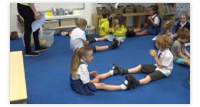
Roll the Ball (pulse, tempo, structure)
For this game, you need sing-song voices and medium sized, spongy balls, one between two. In pairs, the children sit facing each other with wide, outstretched legs and feet touching. The idea is to roll the ball in time with the singing, giving an idea of timing and structure. The best way to teach this is to model it with one of the children as your partner.
Hint - there's a little wait, just enough time to take a big breath, after the word 'again'. If the children rush on, you can put in an extra word 'and' before starting the next time.
- Roll the ball
- Hold it still
- Roll it back again
Hi-Lo, Hi-Lo (pitch)
You need hula hoops for this game, enough for one per child, and a fairly large space is needed to lay them on the ground. Although I don't generally use a piano much in my teaching, it's useful for this game because there's a lot of difference between high and low pitch notes (cover the middle keys with a cloth so that they can't be used). If you don't have a piano, use the longest and shortest chime bars you have, or the biggest xylophone (take the middle bars off first). You will first need to play and sing some high and low pitched notes and name them as high or low until the children begin to understand that it's pitch that changes, not volume - the game then reinforces their perception of pitch.
Everyone sings the song as they walk round and round, weaving in between the hoops. At the end of each verse, choose a different child to come out and play either very high or very low notes. If the note is high, the children jump into a 'boat' (a hoop) and stretch up high, and if the note is low, they crouch down low in the 'sea' (not in a hoop).
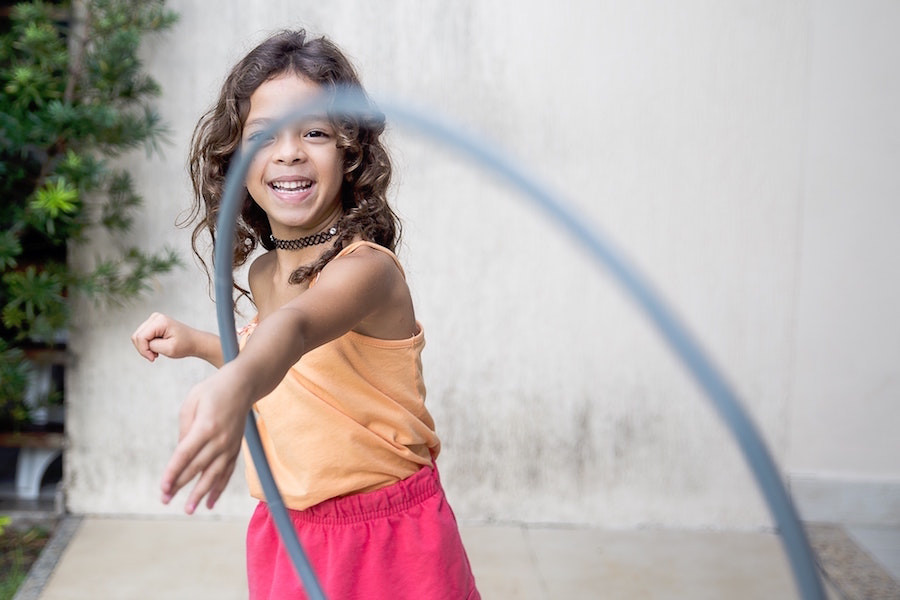
Down the Road (pulse)
A song for practising walking in time to a song.
- Down the road
- Down the road
- Everybody walk together
- Down the road

The Train (pulse, rhythm, tempo)
First say the poem and encourage the children to walk in time to the beat by copying you - they will need lot of practice doing this but it's good practice for keeping a steady pulse!
Next, demonstrate how to the make the rhythm of the word, tickerty-tack by slapping hands on thighs (easier than clapping). Then help the children to do the same – this is great for motor skills because it involves alternating hands!
Say the poem every day for a while, teaching it a line at a time if necessary. Practise starting slowly and very gradually speeding up, like the train gathering speed. Remember to say something like, 'We're making the tempo faster and faster,' so that the children learn the meaning of tempo from the context.
- Tickerty-tack, over the track
- Far away, puffing all day
- Tickerty-too, hurry up, do!
- People can't wait, mustn't be late
- __
- Tickerty-tack, nickerty-nack
- Speeding along, singing a song
- Tickerty-tackerty, pickerty-packerty
- Tickerty-tackerty, TOCK!

My Train Music (structure, rhythm, texture)
When they know the poem, the children can go in pairs or small groups to the music corner to make up their own train music, choosing untuned percussion instruments. At this stage I wouldn't expect all the children to be capable of using 'tickerty-tack' rhythms but that's not important - their music will mean something to them! If the children can work in pairs or groups they might create different textures by playing instruments on their own and also together. Giving a basic structure to the task can enhance creativity (rather than limit it, as you might expect) and you could ask the children to follow a simple story board:
- The whistle blows
- The train starts up
- The train goes very slowly up the hill
- The train comes quickly down the hill
- The train stops
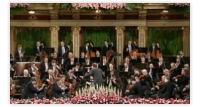
Train Music
Pleasure Train by Johann Strauss II (tempo)
During the 1860s the Southern Railway in Austria ran popular 'pleasure trains', offering surprise journeys with mystery destinations. The title of this piece in the original German language is Vergnügungszug - Polka-schnell, meaning Pleasure Train - Quick Polka. The polka is a lively dance and this one was composed by the younger Johann Strauss (the elder Johann Strauss being his dad) for a grand ball, held in 1864.
I was very surprised to notice that all the musicians in the video are men! There are statistical gender differences in girls' and boys' choices of which instrument they would choose to learn but most European and USA orchestras actually employ a fairly equal balance of men and women.
What to do (tempo, pitch)
The children could imagine where they would like to go on a train journey with friends. Then put them in little groups of three or four to play follow-my-leader, moving quickly as they listen to the music. It is good for the children to watch the video too to become familiar with which instruments make the sounds - ask them if they can spot the glockenspiel. You may have a glockenspiel at school - they are identified by having shiny, smooth metal bars whereas xylophones have wooden bars and metallophones have frosted metal bars.
This is a good time for the children to explore any tuned instruments you have available and for you to help with describing words for high pitched notes, low pitched notes and playing at a fast or slow tempo. Children need lots of exploration and feedback to reinforce the concept of high and low meaning pitch as in notes, not volume as in loudness.

Playing outside (social studies)
The children may be lucky enough to have a play-train in an outside play area. If not you can improvise using chairs put in pairs to make train seats in a carriage. They take turns to be the engine driver and the ticket collector.
Indoor play
Make toy vehicles from Lego.
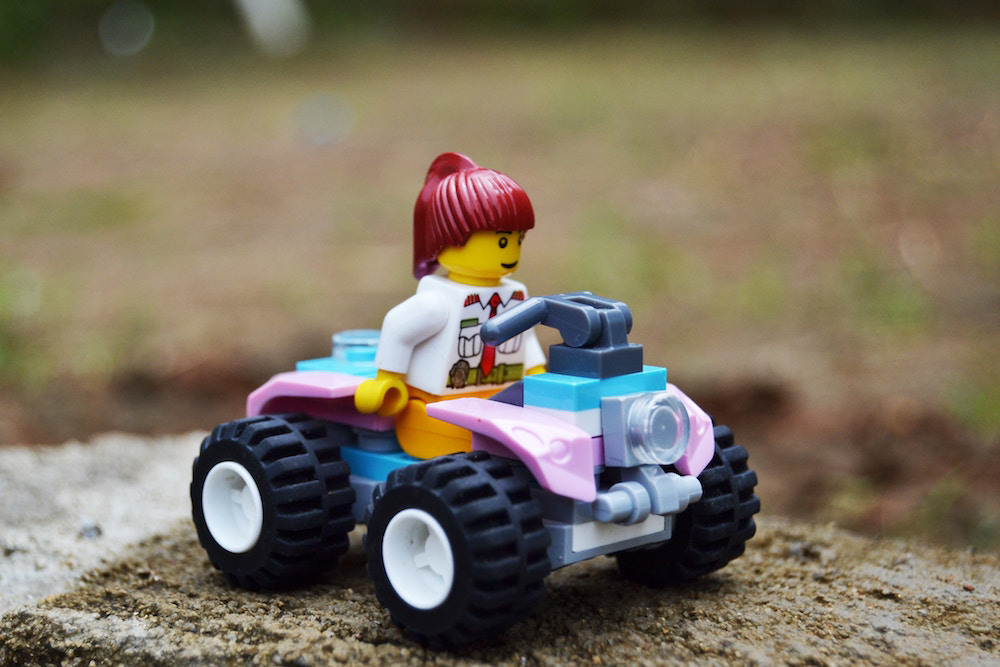



One Two Buckle My Shoe - three ways!
Pulse
A rhyme for going places! It's ideal for doing actions or for tapping knees in time with the pulse. You'll need to model keeping a steady pulse by doing big actions for the children to copy. Here's how it sounds:
Rhythm
The children encounter the same rhythms again later in this unit, in the Creative Music section so this chant is good preparation, followed by later consolidation. Once the children know the words, they can tap out the rhythms too - I suggest you do this just one line at a time in a First Me, Then You way.
Pitch
You can also sing-song this rhyme:
- One two, buckle my shoe
- Three four, open the door
- Five six, picking up sticks
- Seven eight, go through the gate
- Nine ten, say it again!

On the Bus - for developing listening skills
This is an active listening game, good for expending some energy. First, lay parallel lengths of skipping rope to make the 'road', the 'bus' and the 'train'. With the children facing you, show the 'road' in the middle, the train on one side and the bus on the other side and have a little practice moving from one to the other. To play the game, call out in random order:
- 'On the bus'
- 'On the train'
- 'In the road'
It's surprising how much fun this game can be!


Can You Hear the Train? (dynamics, tempo)
The original song, included here with the permission of Lancashire Music Service, the original publishers, was just one verse but I liked it so much that I made up extra ones. When the children know the song, practise singing it slowly and then gradually quicker.
After singing the song, everyone chant 'Chugging along, chugging along' starting slowly and quietly then getting louder and quicker as the train comes closer, then gradually slower and quieter as the train goes away. The teacher leads the tempo (speed) and dynamics (volume changes) by making a big arc shape with arm movements. For the changes in loud and quiet, encourage whispering through to loud voices, but never shouting.
- Can you hear the train?
- Can you hear the train?
- Speeding through the town and then
- Slowing down again
- __
- Can you hear the bus?
- Can you hear the bus?
- Taking children home from school
- Hope it stops for us
- __
- Can you hear the plane?
- Can you hear the plane?
- Taking us on holiday
- Hope it doesn't rain
- __
- Can you hear the car?
- Can you hear the car?
- Driving to the swimming pool
- Hope it isn't far

Lightly Row
This tune seems to appear in virtually every tutor book for every instrument so it's really well-known but I didn't realise for years that it's actually an old song! Verse 1 lends itself to doing rowing and gliding actions and verse 2 could have splashing and swimming actions. I've altered some of the words to make them more suitable for children.
- Lightly row, lightly row
- Over the glassy waves we go
- Smoothly glide, smoothly glide
- On the silent tide
- __
- Watch me splashing in the sea
- Swimming round so easily
- Then I float in our boat
- On the salty sea

Roll the Ball (pulse, tempo, structure)
For this game, you need sing-song voices and medium sized, spongy balls, one between two. In pairs, the children sit facing each other with wide, outstretched legs and feet touching. The idea is to roll the ball in time with the singing, giving an idea of timing and structure. The best way to teach this is to model it with one of the children as your partner.
Hint - there's a little wait, just enough time to take a big breath, after the word 'again'. If the children rush on, you can put in an extra word 'and' before starting the next time.
- Roll the ball
- Hold it still
- Roll it back again
Hi-Lo, Hi-Lo (pitch)
You need hula hoops for this game, enough for one per child, and a fairly large space is needed to lay them on the ground. Although I don't generally use a piano much in my teaching, it's useful for this game because there's a lot of difference between high and low pitch notes (cover the middle keys with a cloth so that they can't be used). If you don't have a piano, use the longest and shortest chime bars you have, or the biggest xylophone (take the middle bars off first). You will first need to play and sing some high and low pitched notes and name them as high or low until the children begin to understand that it's pitch that changes, not volume - the game then reinforces their perception of pitch.
Everyone sings the song as they walk round and round, weaving in between the hoops. At the end of each verse, choose a different child to come out and play either very high or very low notes. If the note is high, the children jump into a 'boat' (a hoop) and stretch up high, and if the note is low, they crouch down low in the 'sea' (not in a hoop).

Down the Road (pulse)
A song for practising walking in time to a song.
- Down the road
- Down the road
- Everybody walk together
- Down the road

The Train (pulse, rhythm, tempo)
First say the poem and encourage the children to walk in time to the beat by copying you - they will need lot of practice doing this but it's good practice for keeping a steady pulse!
Next, demonstrate how to the make the rhythm of the word, tickerty-tack by slapping hands on thighs (easier than clapping). Then help the children to do the same – this is great for motor skills because it involves alternating hands!
Say the poem every day for a while, teaching it a line at a time if necessary. Practise starting slowly and very gradually speeding up, like the train gathering speed. Remember to say something like, 'We're making the tempo faster and faster,' so that the children learn the meaning of tempo from the context.
- Tickerty-tack, over the track
- Far away, puffing all day
- Tickerty-too, hurry up, do!
- People can't wait, mustn't be late
- __
- Tickerty-tack, nickerty-nack
- Speeding along, singing a song
- Tickerty-tackerty, pickerty-packerty
- Tickerty-tackerty, TOCK!

My Train Music (structure, rhythm, texture)
When they know the poem, the children can go in pairs or small groups to the music corner to make up their own train music, choosing untuned percussion instruments. At this stage I wouldn't expect all the children to be capable of using 'tickerty-tack' rhythms but that's not important - their music will mean something to them! If the children can work in pairs or groups they might create different textures by playing instruments on their own and also together. Giving a basic structure to the task can enhance creativity (rather than limit it, as you might expect) and you could ask the children to follow a simple story board:
- The whistle blows
- The train starts up
- The train goes very slowly up the hill
- The train comes quickly down the hill
- The train stops

Train Music
Pleasure Train by Johann Strauss II (tempo)
During the 1860s the Southern Railway in Austria ran popular 'pleasure trains', offering surprise journeys with mystery destinations. The title of this piece in the original German language is Vergnügungszug - Polka-schnell, meaning Pleasure Train - Quick Polka. The polka is a lively dance and this one was composed by the younger Johann Strauss (the elder Johann Strauss being his dad) for a grand ball, held in 1864.
I was very surprised to notice that all the musicians in the video are men! There are statistical gender differences in girls' and boys' choices of which instrument they would choose to learn but most European and USA orchestras actually employ a fairly equal balance of men and women.
What to do (tempo, pitch)
The children could imagine where they would like to go on a train journey with friends. Then put them in little groups of three or four to play follow-my-leader, moving quickly as they listen to the music. It is good for the children to watch the video too to become familiar with which instruments make the sounds - ask them if they can spot the glockenspiel. You may have a glockenspiel at school - they are identified by having shiny, smooth metal bars whereas xylophones have wooden bars and metallophones have frosted metal bars.
This is a good time for the children to explore any tuned instruments you have available and for you to help with describing words for high pitched notes, low pitched notes and playing at a fast or slow tempo. Children need lots of exploration and feedback to reinforce the concept of high and low meaning pitch as in notes, not volume as in loudness.

Playing outside (social studies)
The children may be lucky enough to have a play-train in an outside play area. If not you can improvise using chairs put in pairs to make train seats in a carriage. They take turns to be the engine driver and the ticket collector.
Indoor play
Make toy vehicles from Lego.


